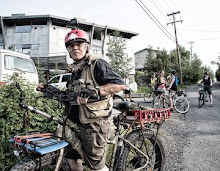 | |  |
| Spot on the Planet | ||
http://www.wentz.net/radiate/cheyla/index.htm
[excerpt]
In the late 1940's, about 80 kilometers north of the city of Chelyabinsk, an atomic weapons complex called "Mayak" was built. Its existence has only recently been acknowledged by Russian officials. Mayak, bordered to the west by the Ural Mountains, and to the north by Siberia, was the goal of Gary Powers's surveillance flight in May of 1960.
For forty-five years, the Chelyabinsk province of Russia was closed to all foreigners. Only in January of 1992 did President Boris Yeltsin sign a decree changing that. As a result, western scientists who studied the region, declared Chelyabinsk to be the most polluted spot on earth.
Forty Years of Nuclear Contamination in Chelyabinsk, Russia

Chelyabinsk, the capital of the Chelyabinsk province in Russia, is located at the eastern foot of the Ural mountains and has a population of 1.3 million. The province has a land area of 90,000 sq. km and a population of 3.6 million.
Abstract
Chelyabinsk was one of the former Soviet Union's main military production centers, which included nuclear weapons manufacturing. Accidents, nuclear waste disposal and day to day operation of the Mayak reactor and radiochemical plant contaminated a vast area of the province. In the early 1950s there were so many occurrences of death and disease from the nuclear waste dumping in the Techa river that 22 villages along the river banks in a 50 kilometers zone downstream from Mayak were evacuated. In 1957, a nuclear waste storage tank accident released radiation double the amount released by the Chernobyl accident. This accident was kept secret and 10,700 people were evacuated. The severe environmental contamination of this region led to dramatic increases in cancer rates, birth defects, and sterility. Over the past 33 years, there has been a 21% increase in the incidences of cancer, 25% increase in birth defects and 50% of the population of child bearing age are sterile.
Cause of the Environmental Crisis
During World War II, Chelyabinsk was one of the Soviet Union's major armament production centers. Entire factories on the western side of the Urals were taken apart and reconstructed on the other side of the Urals, the Chelyabinsk province. Chelyabinsk had one of the largest tank factories in the country, as well as one of the major nuclear armament plants. Due to these "strategic industries" the province was closed to visitors until 1989. Following the political and economic transformation in Russia, the tank factory now produces tractors, and the Mayak nuclear armament plant is trying to evolve into a fast breeder recycling plant for foreign spent-plutonium (nuclear wastes).
The Mayak nuclear complex was one of the Soviet Union's main military production centers. During the last fifty years this complex has contaminated the Chelyabinsk region with highly dangerous nuclear and chemical wastes. The following is a chronological listing of the practices and accidents that caused the environmental crisis:
- 1949 to 1956: Liquid wastes from the Mayak nuclear complex were dumped into the Techa-Iset-Tobol river system


No comments:
Post a Comment